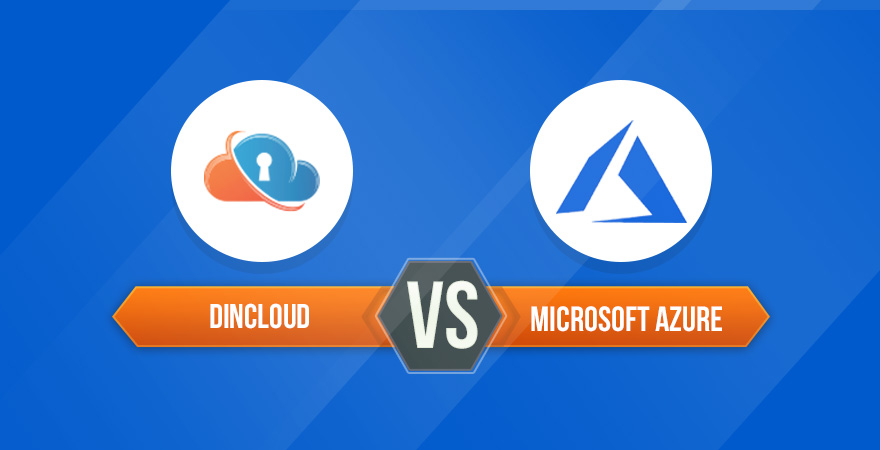The cloud computing market is fiercely competitive. With every Cloud Service Provider (CSP) going the extra mile to woo potential cloud users, these are some of the best times if you are in the market shopping for a cloud solution.

However, as your choice and options expand, so does the difficulty in selecting the cloud provider that ticks all the right boxes. Ironically, most present cloud solutions can be adopted only if you make some compromises to your original wish list.
Well, with dinCloud, that is not the case and in this post, we will compare and contrast the cloud services offered by Microsoft Azure and dinCloud. Towards the end, we will also make the case about why dinCloud is a far better choice on many counts.
As always, the prospecting phase for any cloud solution or service starts with the most basic question, and that is the type and extent of cloud deployment you desire in your organization. There will be a lot of variables at play here, let’s discuss some of them.
Also Read:
- Key Factors to Make Your Organization VDI Ready
- Why Prefer dinWorkspace Over Other Cloud Hosted Desktops?
- Cloud Computing Shines Even Amidst Decline in IT Spending
Partial v/s Full Cloud Transition
This is perhaps the most crucial element of your prospecting phase for any cloud service. If you opt in favor of a partial migration to cloud, you will typically maintain some sensitive or mission critical operations on premise, while outsource the lower priority ones to the cloud.
In case you decide in favor of a full on cloud transition, you will typically decommission your existing on premise IT hardware and fully embrace the cloud. In case of a partial transition, integration related capability and support of your cloud provider will be crucial.
Hybrid v/s Single Cloud Architecture
This will be second most important question you will need to address when assessing cloud solutions and their respective capabilities. In case hybrid cloud is your preferred option, you will have to give top priority to integration capabilities offered by the cloud providers.
Although there has been remarkable progress in the cloud computing landscape when it comes to hybrid cloud environments, you still have to tread this path with care. Each cloud provider is not prepared to forego its core competitive edge to the hybrid cloud.
Microsoft Azure and Its Limitations
In the realm of cloud computing, Microsoft Azure is a name you simply cannot afford to overlook altogether. Decades before Azure became a thing, Microsoft was already an established brand due to its remarkable Windows operating system.
To further complement the Windows revolution, Microsoft introduced the Office suite of enterprise productivity applications. The combination of Windows and Office that was at the disposal of Microsoft paid huge dividends to the tech giant in the cloud as well.
Realizing the potential of Software as a Service or SaaS in the cloud solutions market, Microsoft was quick to virtualize its Office suite of enterprise productivity apps and bundle it with its cloud solutions over Azure.
With this strategy, the otherwise modest cloud solutions of Microsoft Azure suddenly became far more attractive to cloud shoppers, but all this is just one part of the story. Microsoft is very inflexible with the room it allows to external developers.
In most cloud environments, especially that involve a partial transition to the cloud or a hybrid environment, there are a lot of integration challenges that are dealt with through a developer friendly platform, which is highly deficient in the case of Azure.
Therefore, in case of Microsoft Azure, you have to take the cloud solution as a “take it or leave it” option. This however does not suit the preferences of most enterprises adopting some sort of cloud architecture for the first time or in a phased manner.
Another key limitation of the Azure cloud stack is that in its stripped down version that’s without the MS Office productivity suite, the cloud solution is more or less inadequate for the productivity needs of most modern enterprises.
However, supplement your Azure cloud architecture with the MS productivity suite and your cloud bill will swell like anything. As a strategic move, Microsoft now treats Office as a stand alone solution and while it’s good for them, this is not so good for cloud users.
Azure, coupled with Office is more than a decent cloud solution, but one that quickly jumps beyond the reach of most small to medium businesses (SMB) in terms of cost. The cross cloud integration capability of Azure also poses many daunting challenges.
Also Read:
- 17 Best Practices to Attain Secure Remote Work Environments
- Factors Accelerating the Growth of DaaS
- Understanding Cloud Computing Models – IaaS, SaaS and PaaS
Virtualization Solutions by dinCloud
dinCloud has established itself as a leading and innovative Cloud Service Provider in a short span of time. As a vendor agnostic provider of cloud solutions, dinCloud offers unrivaled flexibility to your enterprise, whether it’s a partial transition or a hybrid deployment.

Below, we will list down some of the major competitive advantages you can enjoy with dinCloud’s architecture.
Cross Integration
As dinCloud uses multiple platforms for its cloud services, you don’t have to worry the least bit about integration related bottlenecks.
Whether it’s a partial transition to dinCloud’s architecture or a hybrid cloud environment, our infrastructure seamlessly integrates with on premise or another cloud deployment.
Security
dinCloud’s Security profile has an impeccable track record and it covers both the aspects of physical and cyber security of its multiple data centers.
We secure your valuable data through virtual firewalls, user authentication, malware protection, intrusion detection and strong end to end encryption protocols.
Regulatory Compliance
When you are entrusting your data to any Cloud Service Provider (CSP) like dinCloud, regulatory compliance can be a major cause for concern.
This is particularly true in the backdrop of heavy fines that are being imposed by regulators. Now, data security and regulatory compliance are among top cloud related concerns.
Once you migrate to dinCloud, you will not only be storing your valuable data securely, but also complying with the top international standards for data security.
Customizability
dinCloud’s architecture is highly conducive for both partial and hybrid cloud environments. Our cloud hosted virtual desktops (dinHVD) deliver a seamless Windows 10 experience.
What this means for our end users is that they will feel totally at home with dinCloud and the learning curve for our cloud services will be minimal to none.
Productivity
We offer some of the cloud’s best Desktop as a Service or DaaS solution that packs more than sufficient punch for your enterprise level productivity needs.
dinHVDs can be supplemented with fully virtualized, licensed and patched productivity applications, including MS Office and many more.
Our enterprise grade virtualized software and applications are ideal for a wide range of industries such as finance, healthcare, architecture, contact centers and more.
With dinCloud’s architecture, your productivity options extend way beyond the ones typically offered as part of the MS Office productivity suite.
Cloud Orchestration with dinManage
The biggest issue with most cloud solutions in general and Azure in particular is the little to no room available for developers to manage their cloud infrastructure.
dinCloud on the other hand strongly believes in customer empowerment. We let you sit in the driver’s seat so far as our cloud solutions are concerned.
With this very goal in mind, we have designed dinManage, which is a user friendly web based portal for managing key aspects of our cloud services.
dinManage will enable you to oversee and manage nearly all key aspects of dinCloud’s services, in a way that best aligns with your needs.
Azure either does not allow you any such room for maneuverability and even if it’s there, the accompanying complexity defeats the whole purpose.
Flat Rate Pricing
When it comes to cloud solutions, pricing is a very important consideration. At the end of day, most cloud migrations list cost cutting as the end objective, among others.
Despite the established name and capability, Azure cloud stack is not cheap and becomes prohibitively expensive once you add some essential apps to the mix.
With dinCloud, a major advantage you will enjoy while using our cloud infrastructure is some of the cloud’s most competitive pricing.
The other differentiating factor with dinCloud’s pricing model is total transparency and predictability. We offer our cloud services thru a “flat rate pricing model”.
This in turn not only makes the comparison part easier, but your dinCloud bill also does not come along with any unexpected surprises.
Conclusion
If we delve deeper, we find that dinCloud’s services and solutions are not only better than Azure, but they also give the latter a run for its money.
dinCloud, with its industry leading virtualization solutions, proves strongly that big names are not always the answer to your cloud needs or problems.
Rather, it’s innovative and flexible Cloud Service Providers (CSP) like dinCloud that can easily save the day for you.
Contact Us for your cloud needs with the expectation that once you transition to dinCloud’s infrastructure, you won’t need to look any further.


